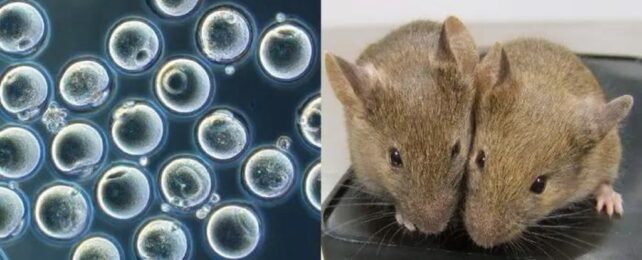Scientists claim they have created mice with two fathers in a breakthrough that could someday be replicated in humans.
Katsuhiko Hayashi from Osaka University told the Human Genome Editing conference on Wednesday that he achieved the breakthrough after changing the chromosomes in a male cell from XY to XX.
He then used that technique to make female eggs, called oocytes, from male cells and fertilized them to create seven mice with two biological dads.
The discovery has yet to be validated by a review of scientific peers and is still in the early stages of development. Still, if it is confirmed, it raises the prospect of male couples someday having their own biological children.
The male-to-female eggs were made from skin cells
Cells are pliable, and with the right prompts, scientists have learned to make them change from one type of cell to another.
To make the egg, the scientists used male skin cells with X and Y chromosomes and reprogrammed them so they would turn into so-called pluripotent stem cells, which are cells that can turn into any other type of cell.
They then deleted the Y chromosomes in the cells and duplicated the cells' X chromosomes, before prompting the cells to turn into egg cells with two X chromosomes.
"The trick of this, the biggest trick, is the duplication of the X chromosome," Hayashi told The Guardian. "We really tried to establish a system to duplicate the X chromosome."
The technique was used to create seven mice pups, which scientists said appeared healthy.
Hayashi says it could be used in humans within a decade, while others disagree
It will be a while before the technology is ready to be used on humans safely.
Mice are very different from humans, and even in mice, the eggs are not of great quality – only one in 100 fertilized eggs led to a live birth, said Hayashi per The Guardian.
Still Hayashi is optimistic. Purely from a technological standpoint, he predicts creating eggs from male cells in humans "will be possible even in ten years," he said, per The Guardian.
He told the BBC he would love to see the technology offer fertility options to same-sex partnerships of all genders down the line. The technique could also help women and people with two X chromosomes who have a genetic issue with one of the X chromosomes to have children, he said.
He cautioned that it would have to be proven to be safe for use beforehand.
"Technically this is possible. I'm not so sure whether at this stage it is safe or acceptable for society," he said.
George Daley, dean of Harvard Medical School who is not involved in the research, told the BBC that the work was "fascinating" and "provocative" but he wasn't so sure this technology would work on human cells anytime soon.
Human reproductive cells are very complex and much less well-known than mice cells. So there is a long path ahead before these fertility options can be offered to humans, said Daley per The Guardian.
The discovery is promising, though this isn't the first time a mouse has been born to two fathers. A 2010 study managed to do this, but their technique required many more steps and manipulation of the embryo and didn't create a viable egg. Hayashi's approach is much more straightforward, per The Guardian.
Hayashi also previously made mice with two biological mothers using this same technique, dating back to 2016. We're yet to be able to make a viable human egg from female skin cells, seven years after Hayashi's paper in female mice, The Guardian reported.
"Scientists never say never, in principle it has been done in mice so, of course, it may be possible in humans," said Haoyi Wang, of the Chinese Academy of Science, to the BBC. But, he added: "I can foresee a lot of challenges and I couldn't predict how many years that would be."
It may be possible, but is it ethical?
If the technology would progress to that point, it would be up to society to decide whether we'd want to allow humans to use it to create children.
Using germline gene editing in humans – when DNA is altered in a way that the manipulation done by scientists will be passed on to the offspring of the children themselves – has typically been a firm red line for scientists.
When scientist He Jankui crossed that line in 2019 and announced he had edited the genes of two babies, he was met with international admonishment and sentenced to prison time.
Still, if Hayashi's research can open up new possibilities for human reproduction, the technology may be considered in the future.
This article was originally published by Business Insider.
More from Business Insider: